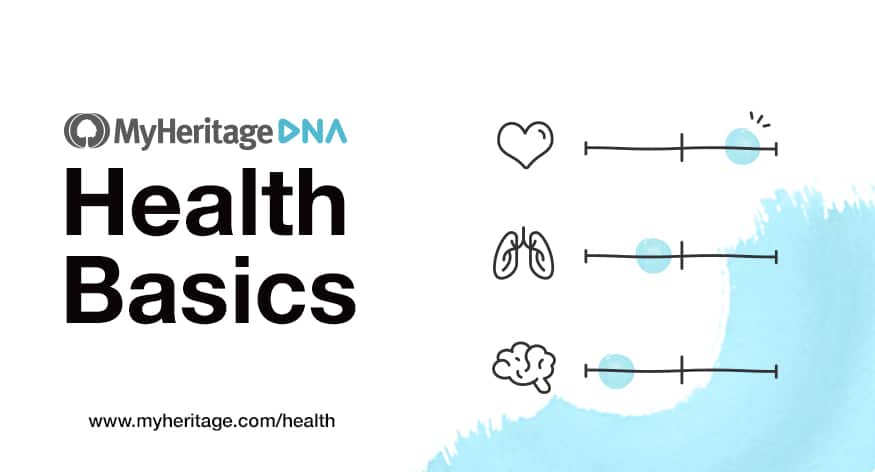

Last month we announced that the MyHeritage DNA Health test includes a fourth polygenic risk report for high blood pressure in addition to its initial 3 polygenic risk reports for type 2 diabetes, heart disease, and female breast cancer. In the first Health Basics post, we explored what a polygenic risk score actually is. In this post, we’ll dig further into what they mean and how they can be applied to your health.
Polygenic risk score (PRS) is a newer development in the world of genetic testing that is now being applied to health. We’ve known that chronic conditions like obesity and heart disease run in families, but prior to the application of PRS to health, we were limited in the ability to determine a person’s genetic risk for these conditions. PRS provides an estimate of the genetic risk to develop certain chronic conditions by looking at variants at many locations across the genome and combining their contributions into a single risk score. This score is calculated by a mathematical model that includes the variants found in the DNA sample you submit and the impact each of those variants has on disease risk.

PRS provides an estimate of the genetic risk to develop certain chronic conditions like heart disease
Polygenic risk scores allow us to go beyond typical measurements of individual risks and instead address a person’s risk category based on their genetics. Take a particular group of people with similar characteristics — middle age, non-smokers without high blood pressure or high cholesterol. Based on these characteristics alone, all of these people would be considered at “average risk” for heart disease. But, intuitively, we know the entire group is not at average risk. Each person has a different risk profile that is influenced by their own genetic make up. PRS allows us to stratify that group into more specific risk categories — increased, average, or decreased — based on genetics.
Let’s take a look at what information is provided on a PRS report. The top portion of the report shows your risk category. Generally, an average risk suggests that your genetic risk is similar to that of the general population. In the “Understanding your lifetime risk” section, the report breaks down your chance to develop the condition between your current age and age 80. This number is considered your “lifetime risk.” It changes as you get older, generally decreasing with each year that you do not develop the condition.
Health is important to all of us, so maintaining a nutritious diet, regular exercise plan, and a normal weight makes sense for everyone. For some people, those lifestyle choices may be sufficient to maintain good health. For others, despite their best efforts, these things may not be enough to help them avoid developing a chronic health condition. Utilizing the results of your PRS can help you and your healthcare provider proactively determine what medical and lifestyle plan is most appropriate for you. Let’s look at an example.

Your PRS can help you and your healthcare provider proactively determine what medical and lifestyle plan is most appropriate
Mary is 41 years old. She takes the MyHeritage DNA Health test and is interested in the results of her PRS for heart disease. Taking into consideration her medical history and current health status, Mary and her healthcare provider might make different decisions about how to direct her care based on her risk category. If she has an increased risk, they might implement additional monitoring, such as cholesterol testing, discuss possible medications or therapies that may help reduce her risk, and/or look at more aggressive lifestyle changes to keep Mary as healthy as possible. With an average risk, Mary will still want to be diligent about going in for regular check-ups. Her healthcare provider will likely address any changes in blood pressure or cholesterol proactively and encourage Mary to watch her weight. Finally, if Mary were to have a decreased risk on her PRS report, her healthcare provider may tell her to keep doing what she’s doing, with the understanding that this doesn’t guarantee that she won’t develop heart disease in the future. Mary will need to maintain a healthy lifestyle regardless.
PRS is a valuable tool that functions best as part of your overall health plan. When thinking about how to incorporate your PRS in to that plan, here are some things you may wish to consider:
- Identify your risk category and lifetime risk estimates on your report. See how this differs from where you expected to be or where you want to be.
- Consider sharing and discussing your report with your healthcare provider.
- With your healthcare provider’s guidance, determine if other testing is recommended to fully assess your risk based on your family or personal medical history.
- Discuss with your provider if other lifestyle modifications are needed.
- Share your results with your family members since they share your genetics!
While polygenic risk scores cannot tell you whether you will or will not develop a certain health condition, they can help you better understand your genetic risk for developing those conditions. Armed with that information and working with your healthcare provider, your PRS can help guide important decisions about your medical care, lifestyle, and environment with the ultimate goal of improving and maintaining your health.
Interested in understanding more about your lifetime risk for complex conditions like high blood pressue, type 2 diabetes, heart disease, and female breast cancer? Visit myheritage.com/health today.











Marge Hurl
January 20, 2020
At my age, 70, I know my health problems which I have passed the info on to younger relatives. I guess that is why I don’t get excited about health reports. I have been physically active my whole life and as an adult I have always had a heart healthy diet. I still developed a heart problem at the same age as my mother did.